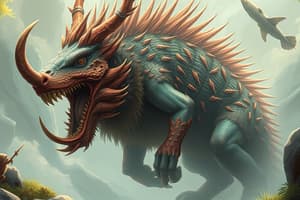Podcast
Questions and Answers
What is the primary basis for grouping organisms into a phylum?
What is the primary basis for grouping organisms into a phylum?
- Body structure and development (correct)
- Habitat and geographical location
- Genetic similarity
- Behavioral patterns and diet
Which of the following is a characteristic of a phylum?
Which of the following is a characteristic of a phylum?
- Common body plan or architecture (correct)
- Same number of species
- Similar genetic code
- Similar environmental adaptations
What is a subphylum?
What is a subphylum?
- A group of organisms that share a common habitat
- A smaller group of organisms within a phylum (correct)
- A group of organisms that share a common diet
- A higher level of classification than a kingdom
Which phylum includes animals with jointed limbs and a hard exoskeleton?
Which phylum includes animals with jointed limbs and a hard exoskeleton?
What is the main benefit of phyla in understanding the diversity of life on Earth?
What is the main benefit of phyla in understanding the diversity of life on Earth?
Why are phyla important in making predictions about the characteristics of organisms?
Why are phyla important in making predictions about the characteristics of organisms?
Study Notes
Phylum Definition
- A phylum is a level of classification in biology that ranks above class and below kingdom
- It is a grouping of organisms based on their body structure and development
Characteristics of a Phylum
- A phylum typically includes organisms that share a common body plan or architecture
- Members of a phylum often have similar developmental patterns and embryonic structures
- Phyla can be divided into subphyla, which are smaller groups of organisms that share more specific characteristics
Examples of Phyla
- Chordata: includes animals with a notochord (a flexible, rod-like structure) at some stage in their development
- Arthropoda: includes animals with jointed limbs and a hard exoskeleton
- Mollusca: includes animals with soft, unsegmented bodies and often a shell
- Echinodermata: includes animals with radial symmetry and a unique body plan
Importance of Phyla
- Phyla provide a way to categorize and understand the diversity of life on Earth
- They help scientists to identify relationships between different organisms and to reconstruct evolutionary histories
- Phyla can be used to make predictions about the characteristics and behaviors of organisms that have not been studied in detail
Phylum Definition
- Ranks above class and below kingdom in biological classification
- Groups organisms based on body structure and development
Characteristics of a Phylum
- Shares common body plan or architecture
- Similar developmental patterns and embryonic structures
- Divisible into subphyla with more specific characteristics
Phylum Examples
- Chordata: notochord at some stage in development
- Arthropoda: jointed limbs and hard exoskeleton
- Mollusca: soft, unsegmented bodies and often a shell
- Echinodermata: radial symmetry and unique body plan
Importance of Phyla
- Categorize and understand life on Earth's diversity
- Identify relationships between organisms and reconstruct evolutionary histories
- Make predictions about unstudied organisms' characteristics and behaviors
Studying That Suits You
Use AI to generate personalized quizzes and flashcards to suit your learning preferences.
Description
Learn about the definition and characteristics of a phylum in biology, including its ranking in classification, body structure, and developmental patterns.




